
Related Content
March 2022 — This section explores market opportunities for new lodging accommodations in the downtown area. It will help you understand travel and visitation trends, existing competition, traveler market segments in the area, and projected room night demand. This section will help you project the occupancy and average room rate, key variables in determining the viability of a new hotel downtown.
Hotels can be an extremely valuable addition to a downtown area. They bring leisure visitors and business people to the heart of a community. They can fill a compelling market need by accommodating visitors to area businesses and institutions. Hotels can generate sales for nearby retail and service businesses and capture tourism dollars in the community. Hotels also generate significant tax revenues while creating many new jobs for local residents.
Because of their central location, downtowns often provide investment opportunities for hotel development. Downtown sites are typically within close proximity to businesses and industry, colleges, hospitals, attractions, services and entertainment. These are important generators of room-night demand.
Market conditions in your area have a significant impact on the feasibility of a new hotel. The strength of the local lodging market affects how many rooms you can sell and the rates that you can charge. This section will help you analyze your community so that you can gauge the market potential of a new lodging facility. This analysis is especially important in demonstrating the potential of downtown locations, as many lodging developers often prefer suburban or highway sites.
This section will help you collect and analyze information as part of a lodging market analysis. The analysis is tailored to the hotel/motel industry and should answer the following:
- What trends are occurring in the lodging industry?
- Are local economic and visitation trends favorable?
- Who are the competitors and how successful are they?
- What are the potential lodging market segments in the area?
- What occupancy and average room rate could a new property achieve?
Using your projections of occupancy and average room rate, you can begin to estimate whether a new lodging facility would make financial sense in your downtown.
The material that follows include data collection and analysis techniques as outlined in the flowchart. While the part on projecting sales volume should be the final step, the other parts can be completed in any order.
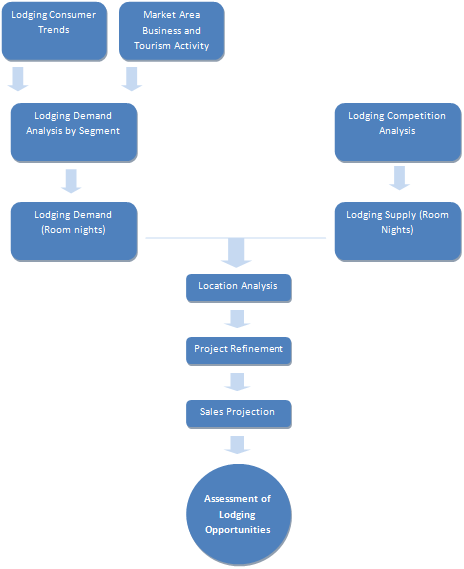
Lodging Consumer Trends
National and regional industry trends need to be considered as they may affect the profitability of a new lodging operation in your community. Relevant trends might include the growth in demand for overnight accommodations, changes in travelers’ lodging needs, and new, innovative properties that are opening around the country.
There are various sources of trend information including the American Hotel and Lodging Association; state and local hotel/motel associations; hospitality industry libraries available at many colleges and universities; industry publications (such as Cornell Hotel and Restaurant Quarterly, Hotel & Motel Management and Lodging); web sites such as hotel-online.com. Other industry-related research is provided by firms specializing in the lodging industry (such as Smith Travel Research).
The following provides a sample of topics you might want to study as part of your market analysis. Be sure to expand this list as needed.
- Growth in Industry – limited service vs. full service, chain vs. independent, downtown vs. suburban, etc.
- Market Demand – occupancy and room rates, business travel trends, leisure travel trends, group travel trends, and lodging preferences of various market segments.
- Market Supply – aging of existing lodging facilities, new types of properties, growth in the number of properties, and alternative lodging accommodations (such as bed & breakfast operations and inns).
- Success and Failure Factors – service, facilities, amenities, pricing practices, reservation systems, efficient property sizes, debt-to-sales and other financing statistics.
Market Area Business and Tourism Activity
Hotels that primarily serve business travelers usually rely on the strength of the local business community. The size, stability and diversity of major local employers are important factors that should be researched. Plans for future business development should also be studied including growth in professional and technical employment. Local planning officials and chambers of commerce are good sources for this information. Ask for information to help you understand trends over the past ten years and the future outlook.
Hotels in resort areas typically rely on local attractions to bring in customers. Attractions may include natural or scenic sites, recreational activities, cultural or historic sites, special events and shopping and entertainment. Operators of these attractions can sometimes provide you with estimates of attendance and seasonality trends.
An analysis of the transportation network serving the market area is also important. Existing streets and highways and proposed improvements should be identified. Distances to feeder markets (where the guests originate) may be particularly important for resort hotels. Local economic and demographic trends should also be considered.
Examine the following market area characteristics and include all information relevant to a new property in your community. Use several years’ data to identify trends.
- Business and Economic Characteristics – room tax collections, eating and drinking place sales, retail sales, employment (levels, types, major employers), office/industrial space occupied, and existing and future major employers.
- Tourism and Recreation Characteristics – visitation to parks, lakes, beaches, museums, casinos, festivals and events and other attractions.
- Transportation Factors – distance from major cities, traffic counts, airport service, ferry volume and passenger rail volume.
*Municipal room tax collections can provide you with a measure of the growth in lodging revenues during the past three to five years. This is typically a reliable source of data to supplement your analysis of area competition.
Lodging Demand Analysis by Segment
Based on local business and tourism activity, you should identify what market segments of overnight guests visit your community. These market segments typically fall into four categories: business, leisure, group, and other.
Business Travelers
Business travelers represent a large portion of lodging demand in many market areas. They include people traveling on business representing commercial, industrial and governmental organizations. Peak business demand is usually experienced Monday through Thursday nights.
It is important to understand why business travelers are visiting the market area and how many room nights they generate. Reasons for visiting a particular area might include conducting business with a local company (recruiting, training and management meetings); calling on multiple businesses (by suppliers, vendors and sales representatives); and stopping over between destinations.
Interviews with local business representatives can be the most effective way to estimate how many room nights they might generate. Questions to ask include type of visitors, frequency of visits, length of stay, where most visitors tend to stay and what rate range is acceptable.
Leisure Travelers
Leisure travelers may visit an area for a vacation, to attend sporting or social events, to shop, or to visit friends and relatives. They might be staying over simply because they are traveling to other destinations. Leisure travelers may be individuals, couples, families, or small groups. Travelers visiting hospitals and universities are typically included in this market segment.
Leisure room demand is often seasonal. In larger, more urban market areas, leisure room demand may be limited to weekends, summer months and holiday periods. To measure the significance of leisure demand in your market area, interview the local visitor bureau, chamber of commerce and local event and attraction operators. Also, study variations in room rates by day of week and time of year. Higher rates usually indicate periods of higher occupancy. Finally, inspect local hotels to determine if they have been designed to serve leisure travelers. Recreational facilities such as pools, fitness centers, tennis courts, snowmobile trails and other features may indicate the importance of leisure travelers to a particular property.
Group Meeting Travelers
The group market consists of both leisure and business travelers. Leisure groups include bus tours, school activities, athletic events, etc. Tour groups are often brought to an area for sightseeing and attending special events. Local attractions that appeal to leisure tour groups may have records of the numbers and names of tour operators who have visited their attractions. The National Tour Association and American Bus Association, among others, can provide information on tour activities.
Business group meetings are typically associated with conferences, board meetings, training programs, seminars, trade shows, and other gatherings. Often the sponsoring organization will be from the local area. Out-of-town organizations may use local meeting facilities because they often rotate the sites of their regional meetings. Your community’s convention and visitor’s bureau or chamber of commerce can usually provide a good estimate of local group meeting activity.
Other Travelers
Various lodging customers cannot be classified under the categories of business, leisure, or group. These travelers may include construction workers, truckers, utility crews, airline personnel and others. Activity at local truck stops, distribution centers, long-term construction projects and other sources of demand could help you estimate the significance of this market segment.
Lodging Competition Analysis
The most important part of a lodging market analysis is the study of current and proposed competition. The operating performance of existing local competition is a key indicator of market potential. Conduct interviews with area hotel operators to effectively complete this part of your study.
An important part of your competition analysis is estimating the monthly and annual operating performance of each competitive property. Performance can be measured in terms of occupancy percent and average daily room rate.
Occupancy Percent = number of rooms sold / number of rooms available
Average Daily Room Rate = total room revenue / number of rooms sold
In addition to occupancy and average room rates, each operation should be carefully studied to determine its strengths, weaknesses and competitive position in the market area.
Information on your competition can be obtained from interviews with management, hotel websites, and state and local lodging directories.
You should also investigate any plans for other new lodging operations in the area. Too many new rooms can lead to depressed occupancy levels and “price wars.” Local planners and the development departments of hotel companies are usually aware of developments proposed for your community.
The following items will help you analyze each competitor.
- Location – proximity to sources of lodging demand, accessibility, visibility and surrounding neighborhood
- Facility – age, exterior appearance and condition, interior appearance and condition, cleanliness, signage, types of rooms (suites, standard room,…), food and beverage outlets, function rooms and recreation (pool, fitness center)
- Service – quality of service and extra services offered
- Operating Information (from managers) – weekday vs. weekend demand patterns, historical occupancy growth or decline, monthly occupancy levels, number of 100% occupancy days per month, average room rate per month (after any discounts), major market segments served per month and major sources of demand
- General Information – number of rooms, months open, published rates, franchise affiliation, ratings on travel websites, local reputation and plans for expansion or improvements
Location Analysis
Location is a critical consideration because it impacts your ability to draw customers. It is important that your location be visible, accessible, convenient and attractive to your market. Surrounding land uses are important for all types of lodging operations. High traffic volume is very important. Aesthetics of the area, noise, safety and other factors should be considered. How you evaluate your location will depend on the type of property you are considering and the customers you hope to serve.
Hotels benefit from high visibility and proximity to generators of room night demand. Local colleges, hospitals, attractions, services and entertainment are examples of “room night” demand generators. Be sure to consider future growth patterns when analyzing your location.
Hotels in resort areas generate most of their business from leisure travelers who see the lodging facility and surrounding area as their “destination.” Access and visibility, while important, are secondary to the quality of the facility, services, amenities, and nearby attractions.
Different types of lodging operations will have different location requirements. Analyze your location using the factors listed below. Be sure to consider other location criteria for your particular hotel development.
- Description of Immediate Area – commercial profile, adjacent land uses, proposed developments, safety, and availability of nearby services (food, services, shopping)
- Proximity to Demand Generators – businesses, colleges, hospitals and other institutions, convention facilities, and tourist attractions (museums, historical sites, recreation).
- Traffic Volume – highway/street traffic counts and traffic patterns
- Accessibility – proximity to major streets and highways, ease of entrance and exit
- Other Issues – Site size and social, political and environmental concerns related to development downtown.
Project Refinement
In planning for a new downtown hotel, it is essential to understand the lodging needs of people visiting your community. Using data already gathered, this part will help you refine your proposed hotel concept so that it can effectively serve your market area.
Segments of the industry include luxury, full service, midmarket, economy, resort, extended stay and subcategories of these hotels. It is important to match the lodging concept (or segment) considered with the needs of travelers to the area. For example, the extended stay hotel concept works best in areas with a high concentration of office and corporate headquarters that bring in people for longer stays.
One of the most important considerations in refining your hotel project is estimating the total number of guest rooms. Optimum room size is dependent on a number of variables including market area room demand as measured by occupancy rates; financial resources available to the developer and minimum room size allowed by a franchiser. Keeping the project within the optimum size range will help ensure financial success while reducing the risk of over-building within a market area.
Using the items below identify development criteria for a new hotel in your downtown area.
- Affiliation – independent or chain.
- Product Category – limited or full service
- Room Type and Number – standard rooms, suites and specialty rooms
- Amenities and Facilities – restaurant and lounge, function facilities, recreation (pool and fitness center).
- Market Area to be Served – as defined by primary competition.
- Market Segments to be Served – business, leisure, group and other categories.
- Expected Price Range – peak and slow periods
Sales Projection
Room sales in a hotel are a function of occupancy percent and average room rate as defined earlier. A key indicator of future performance is the past performance of other properties in the market area. The steps that follow will help you estimate your occupancy, room rate and resulting sales potential.
Step 1: Project Market Area Annual Occupancy
Project the occupancy for your entire market area for the coming year using the following procedure. See the following example as a guide for projecting market area occupancy.
- Under Area Hotels, list all of the competitive properties in your market area. If you are an existing operator, be sure to include your own property.
- For each property, record the Days Open, Rooms in the property, and the estimated Occupancy Percent.
- For each property, calculate and record the number of Rooms Available per year by multiplying Days Open by Rooms. Sum the Rooms Available column.
- For each property, calculate and record the number of Rooms Sold per year by multiplying Rooms Available by Occupancy Percent. Sum the Rooms Sold column.
- Calculate the current market occupancy by dividing the sum of Rooms Sold by Rooms Available.
- Looking ahead to next year, record any additional rooms (New Room Supply) that will be added to the market area. Include your planned downtown hotel here.
- For next year, record additional growth in room night demand might occur as a result of improving economic conditions, tourism visitation, or simply as a result of having new lodging rooms added to the market area.
- Record the Total Area Rooms Available and Rooms Sold for next year (current year totals plus additions from steps F and G). Calculate next year’s market occupancy by dividing Rooms Sold by Rooms Available.
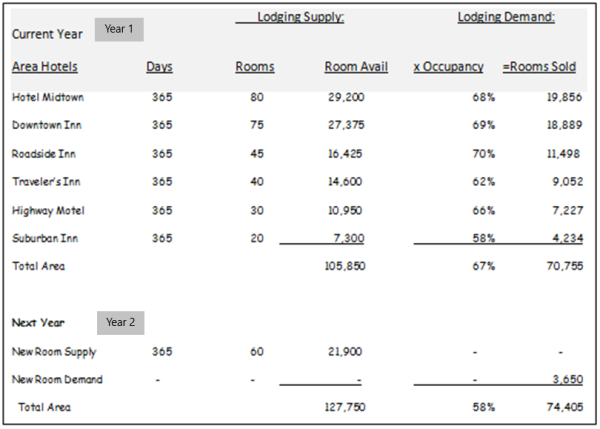
Step 2: Project Your Property’s Capture of Market Area Annual Occupancy
Based on your hotel’s relative strengths and weaknesses, determine if a downtown property will achieve an occupancy higher or lower than the market occupancy projected in step one. Compare your proposed operation with the competitive properties in your market area using the criteria in the example Strengths-Weaknesses grid (see grid below). Be sure to keep in mind the types of travelers that make up local lodging demand. Then, estimate your proposed property’s occupancy projection based on these strengths and weaknesses.
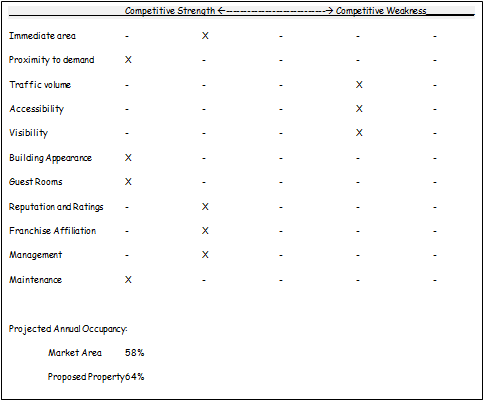
Step 3: Check the Reasonableness of Your Occupancy Projection
Once you have projected your annual occupancy, determine if it is reasonable given the historic seasonal demand patterns in the market area. First, identify the seasonal trends for each market segment. Based on these demand patterns, estimate monthly occupancy levels. The average occupancy level for the 12 months should be similar to your annual projection in step 2. See the following example.

Step 4: Project Your Average Room Rate
Effective pricing is critical in the lodging business as increases or decreases in rates have a major impact on the “bottom line.” Setting prices to maximize profit is an important process that requires consideration of the rates charged by competitors and the price sensitivity of travelers to the area. The following four steps will help ensure that you are competitively priced relative to your competition.
- Analyze your expected market segments. What factors do they consider when choosing a lodging facility (such as location, service, condition, and affiliation)?
- Compare your expected quality level and appeal with that of your competitors. Make this comparison using the factors identified in step 2.
- Analyze the room rates charged by your competitors. Consider single and double rates, discounting, and variations in rates by season. Estimate their average annual room rate.
- Project your average annual room rate by considering the rates and quality levels of your competitors. Your rates must be acceptable to the market segments you are targeting.
Step 5: Project and Analyze Your Sales
After you have developed projections of occupancy and average room rate, you will be able to calculate the projected room revenue. These performance estimates can then be compared with industry standards to determine whether the project would be attractive to a developer. See the following example.
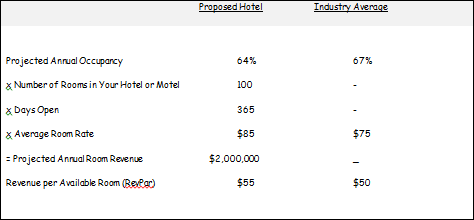
Analyzing the Results
Once your calculations are complete, compare your annual occupancy, average room rate and RevPar projections with state and national averages (see “industry trends” earlier in this section). Study these projections carefully to make sure they are realistic.
If your projections are near or above the state or national averages for the type of property you are proposing, lodging should be considered a possible market opportunity for your downtown area. While more detailed feasibility work will be needed, this assessment should provide developers with an important market overview of lodging development opportunities downtown.
Appendix – Using GIS to Demonstrate Downtown’s Location Advantage
Downtown hotels often have location advantages over suburban properties. They are often closer to major demand generators such as hospitals, colleges and large employers. In addition, they often have a high concentration of dining, entertainment, retail, and other services that complement a visitor’s overnight stay.
GIS can be used to identify these advantages and provide data to prospective investors as a means of attracting development downtown.
One method of demonstrating downtown’s location advantage is to measure its proximity to local lodging demand generators. This can be done using GIS as follows:
- Identify a point that represents the center of the downtown area
- Identify a point that represents the concentration of suburban hotels
- Identify points that represent major demand generators in the community
- Measure the average distance from downtown to the major demand generators
- Measure the average distance from the suburban hotels to the major demand generators
- Compare downtown with the suburban hotels to determine its proximity advantage
Using GIS, this analysis could be presented as illustrated on the maps that follow. Based on this analysis, downtown is significantly closer to the main demand generators identified (average distance of 1.4 miles from downtown compared to 5.5 miles from the suburban location). This supports the argument to locate a hotel downtown because it is centrally located and closer to the major demand generators in the community.
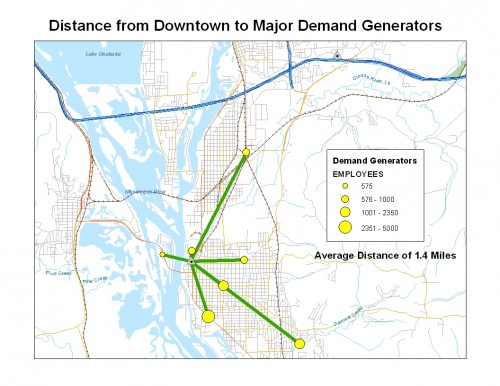

About the Toolbox and this Section
The 2022 update of the toolbox marks over two decades of change in our small city downtowns. It is designed to be a resource to help communities work with their Extension educator, consultant, or on their own to collect data, evaluate opportunities, and develop strategies to become a stronger economic and social center. It is a teaching tool to help build local capacity to make more informed decisions.
This free online resource has been developed and updated by over 100 university educators and graduate students from the University of Wisconsin – Madison, Division of Extension, the University of Minnesota Extension, the Ohio State University Extension, and Michigan State University – Extension. Other downtown and community development professionals have also contributed to its content.
The toolbox is aligned with the principles of the National Main Street Center. The Wisconsin Main Street Program was a key partner in the development of the initial release of the toolbox. One of the purposes of the toolbox has been to expand the examination of downtowns by involving university educators and researchers from a broad variety of perspectives.
The current contributors to each section are identified by name and email at the beginning of each section. For more information or to discuss a particular topic, contact us.


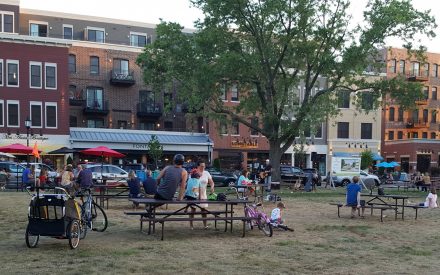

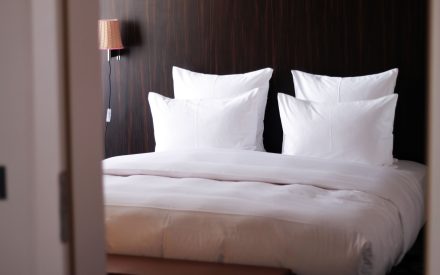

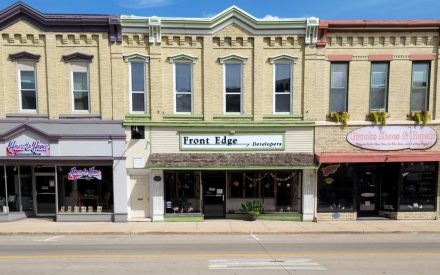

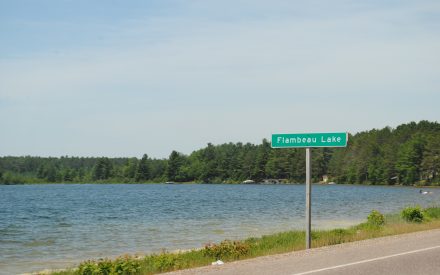
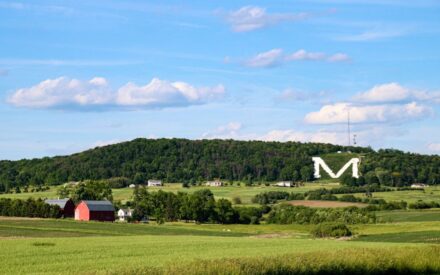

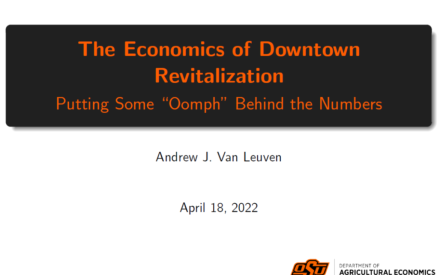

 Focus Group Analysis Tips
Focus Group Analysis Tips


